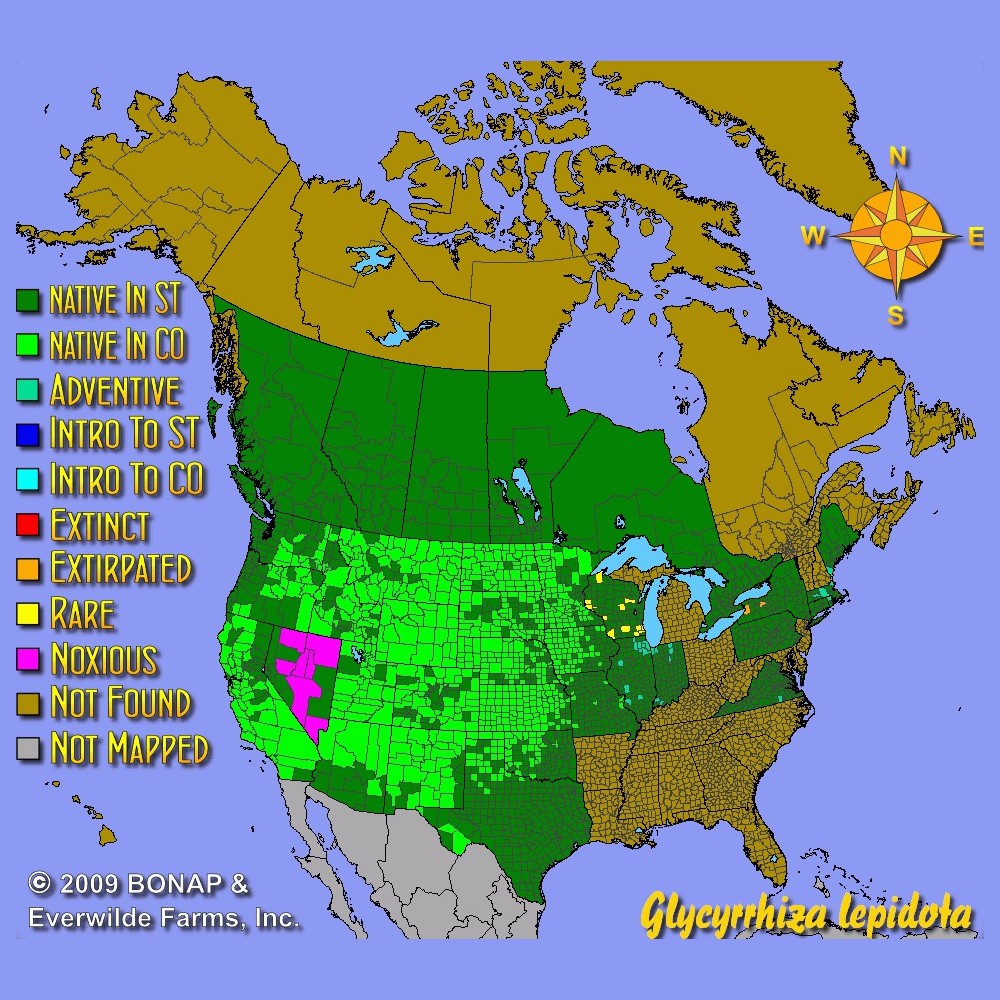Wild Licorice Seeds
- HOW TO GROW
- FAST FACTS
- REVIEWS
HOW TO GROW
Sowing: Before planting, pour 180 degrees F water over the seed and let it soak overnight. In late fall or early spring, direct sow the treated seed 1/4" deep. To start the seed indoors, sow wild licorice seeds in a flat or individual peat pots 6-8 weeks before the last frost; keep the soil lightly moist and at a temperature of 70 degrees F until germination, which usually occurs within two weeks. When the weather has warmed and the seedlings are well established, transplant outdoors.
Growing: Keep the soil moist as the seedlings develop. This wild licorice plant prefers moist, sandy soil. It grows rather slowly at first because of its extensive root system, which takes much of its energy in the first stages of growth. Mature plants self-seed and may spread by rhizomes in good growing conditions; these plants can also be divided in spring or fall. Since this plant has low drought tolerance, it may need watering in dry weather. We cannot sell this seed to customers in WY.
Harvesting: These blossoms do not perform well as cut flowers, and are best enjoyed in the garden.
Seed Saving: After flowering, this wild licorice plant will produce clusters of 1/2-1" brown pods covered with hooked barbs. Remove the pods as soon as they have turned brown, and split them to harvest the reddish-brown Glycyrrhiza Lepidota seeds inside. Store the cleaned wild licorice seeds in a cool, dry place.
FAST FACTS
Common Names: American Licorice
Latin Name: Glycyrrhiza lepidota
Species Origin: US Native Wildflower
Type: Native Wildflowers
Life Cycle: Perennial
USDA Zones: 2, 3, 4, 5, 6, 7, 8, 9, 10, 11
US Regions: California, Mountain, Arid/Desert, Plains/Texas, Midwest, Northern, Northeast
Seeds per Ounce: 3,600
Stratification: No Stratification
Germination Ease: No Stratification
Sunlight: Full Sun, Part Sun
Height: 24 Inches
Color: Cream
Bloom Season: Blooms Early Summer
Wild Licorice Seeds
This white and cream licorice is used for erosion control, and the root system that can be 12 feet long. I use the root for my arthritis. This plant can grow in poor soil and fix it by adding nitrogen to the soil. The seeds are eaten by Birds & Deer.
already sprouting
good job they are already sprouting
DESCRIPTION

HOW TO GROW
Sowing: Before planting, pour 180 degrees F water over the seed and let it soak overnight. In late fall or early spring, direct sow the treated seed 1/4" deep. To start the seed indoors, sow wild licorice seeds in a flat or individual peat pots 6-8 weeks before the last frost; keep the soil lightly moist and at a temperature of 70 degrees F until germination, which usually occurs within two weeks. When the weather has warmed and the seedlings are well established, transplant outdoors.
Growing: Keep the soil moist as the seedlings develop. This wild licorice plant prefers moist, sandy soil. It grows rather slowly at first because of its extensive root system, which takes much of its energy in the first stages of growth. Mature plants self-seed and may spread by rhizomes in good growing conditions; these plants can also be divided in spring or fall. Since this plant has low drought tolerance, it may need watering in dry weather. We cannot sell this seed to customers in WY.
Harvesting: These blossoms do not perform well as cut flowers, and are best enjoyed in the garden.
Seed Saving: After flowering, this wild licorice plant will produce clusters of 1/2-1" brown pods covered with hooked barbs. Remove the pods as soon as they have turned brown, and split them to harvest the reddish-brown Glycyrrhiza Lepidota seeds inside. Store the cleaned wild licorice seeds in a cool, dry place.
FAST FACTS
Common Names: American Licorice
Latin Name: Glycyrrhiza lepidota
Species Origin: US Native Wildflower
Type: Native Wildflowers
Life Cycle: Perennial
USDA Zones: 2, 3, 4, 5, 6, 7, 8, 9, 10, 11
US Regions: California, Mountain, Arid/Desert, Plains/Texas, Midwest, Northern, Northeast
Seeds per Ounce: 3,600
Stratification: No Stratification
Germination Ease: No Stratification
Sunlight: Full Sun, Part Sun
Height: 24 Inches
Color: Cream
Bloom Season: Blooms Early Summer
Reviews
Review
Wild Licorice Seeds
This white and cream licorice is used for erosion control, and the root system that can be 12 feet long. I use the root for my arthritis. This plant can grow in poor soil and fix it by adding nitrogen to the soil. The seeds are eaten by Birds & Deer.
Review
already sprouting
good job they are already sprouting




